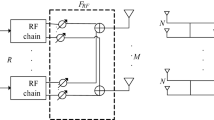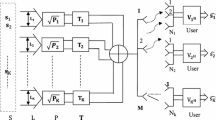Abstract
An optimal linear precoding scheme based on Particle Swarm Optimization (PSO), which aims to maximize the system capacity of the cooperative transmission in the downlink channel, is proposed for a multicell multiuser single input single output system. With such a scheme, the optimal precoding vector could be easily searched for each user according to a simplified objective function. Simulation results show that the proposed scheme can obtain larger average spectrum efficiency and a better Bit Error Rate (BER) performance than Zero Forcing (ZF) and Minimum Mean Square Error (MMSE) algorithm.
Similar content being viewed by others
References
Sheng Jing, David N. C. Tse, Joseph B. Soriaga, et al.. Multicell downlink capacity with coordinated processing. EURASIP Journal on Wireless Communications and Networking, 2008(2008)1, 1–19.
B. L. Ng, J. Evans, S. Hanly, et al.. Distributed downlink beamforming with cooperative base stations. IEEE Transactions on Information Theory, 54(2008) 12, 5491–5499.
Luca Venturino, Narayan Prasad, and Xiaodong Wang. Coordinated linear beamforming in downlink multi-cell wireless networks. IEEE Transactions on Wireless Communications, 9(2010)4, 1451–1461.
A. Sanderovich, O. Somekh, and S. Shamai (Shitz). Uplink macro diversity with limited backhaul capacity. IEEE International Symposium on Information Theory, Nice, France, June 2007, 11–15.
Amichai Sanderovich, Oren Somekh, H. Vincent Poor, et al.. Uplink macro diversity of limited backhaul cellular network. IEEE Transactions on Information Theory, 55(2009)8, 3457–3478.
S. Shamai (Shitz) and B. M. Zaidel. Enhancing the cellular downlink capacity via co-processing at the transmitting end. Vehicular Technology Conference, Rhodes, Greece, 2001, 1745–1749.
H. Zhang and H. Dai. Cochannel interference mitigation and cooperative processing in downlink multicell multiuser MIMO networks. EURASIP Journal on Wireless Communications and Networking, 2004 (2004)2, 222–235.
O. Somekh, O. Simeone, Y. Bar-Ness, et al.. Distributed multi-cell zero-forcing beamforming in cellular downlink channels. IEEE Global Telecommunications Conference, San Francisco, USA, 2006, 1–6.
Q. H. Spencer, A. L. Swindlehurst, and M. Haardt. Zero-forcing methods for downlink spatial multiplexing in multi-user MIMO channels. IEEE Transactions on Signal Processing, 52(2004) 2, 461–471.
S. Shim, J. S. Kwak, R. W. Heath, et al.. Block diagonalization for multi-user MIMO with other-cell interference. IEEE Transactions on Wireless Communications, 7(2008)7, 2671–2681.
Fang Shu, Li Lihua, and Zhang Ping. Optimal multiuser MIMO linear precoding based on particle swarm optimization. Proceeding of the International Conference on Communications, Beijing, China, May 2008, 3355–3359.
J. Kennedy and R. C. Eberhart. Particle swarm optimization. Proceeding of the IEEE International Conference on Neural Networks, Perth, Australia, 1995, 1942–1948.
Jacob Robinson and Yahya Rahmat-Samii. Particle swarm optimization in electromagnetics. IEEE Transactions on Antennas and Propagation, 52(2004) 2, 397–407.
Marco Mussetta, Stefano Selleri, Paola Pirinoli, et al.. Improved particle swarm optimization algorithms for electromagnetic optimization. Journal of Intelligent and Fuzzy Systems, 19(2008)1, 75–84.
Hei Yong-qiang, Li Xiao-hui, Yi Ke-chu, et al.. Multi-user MIMO broadcast system grouping strategy based on particle swarm optimization. International Conference on Advanced Information Networking and Applications, Bradford, United Kingdom, 2009, 212–216.
Hei Yong-qiang, Li Xiao-hui, Yi Ke-chu, et al.. Multiuser scheduling in downlink MIMO systems using particle swarm optimization. IEEE Wireless Communication and Network Conference, Budapest, Hungary, 2009, 1–5.
Author information
Authors and Affiliations
Corresponding author
Additional information
Supported by the National Natural Science Foundation of China (No. 60972041, No. 60572130); Open Research Foundation of National Mobile Communications Research Laboratory, Southeast University, Natural Science Fundamental Research Program of Jiangsu Universities (No. 08KJD510001); Ph.D. Program Foundation of Ministry of Education (No. 200802930004); National Special Project (No. 2009ZX03003-006); and the Science Foundation of Henan University of Technology (No. 09XGG010).
Communication author: Song Rongfang, born in 1964, male, Professor, Ph.D. Supervisor. College of Telecommunications & Information Engineering, Nanjing University of Posts and Telecommunications, Nanjing 210003, China.
About this article
Cite this article
Zhang, R., Song, R. A linear precoding strategy based on particle swarm optimization in multicell cooperative transmission. J. Electron.(China) 28, 15–21 (2011). https://doi.org/10.1007/s11767-011-0472-5
Received:
Revised:
Published:
Issue Date:
DOI: https://doi.org/10.1007/s11767-011-0472-5




